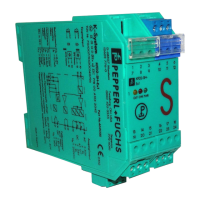2017-04
20
Functional Safety KFD2-SH-Ex1(.T)(.OP), KHA6-SH-Ex1
Operation
Proof Test Procedure
1. Prepare a test set-up, see figure below.
2. Simulate the state of the sensor
- by a potentiometer of 4.7 k (threshold for normal operation),
- by a resistor of 220 (short circuit detection) and
- by a resistor of 150 k (lead breakage detection)
3. Connect a load of 1.3 k to the voltage output of the .T(.OP) device.
4. Supply the relay contact output by 24 V DC externally. Connect an 1 k
resistor as load to the relay contact output. Test this configuration with a
multimeter for the state (on).
5. For versions with triplicated relays, test each single relay with a multimeter if
the off state is reached.
The input threshold must be between 2.1 mA and 2.8 mA. The hysteresis
must be between 170 µA and 250 µA (measured with input multimeter and
potentiometer).
If the input current is above the threshold,
- the voltage output must be activated, voltage level higher than 20 V DC
(.T(.OP) version only),
- the relay contact output must conduct (approx. 24 mA over 1 k),
- the yellow LED must be on.
6. For the functional safety it is important that the voltage output is definitely off
(less than 1 V DC) and each single relay contact output is definitely open
(high impedance), if the input is below the lower threshold (typ. 2.5 mA) or
above the higher threshold (typ. 6 mA).
7. Connect the resistor R
SC
(220 ) or the resistor R
LB
(150 k) to the input.
The red LED must indicate the fault, the voltage output is off, the relay
contact outputs are high impedant (> 100 k).

